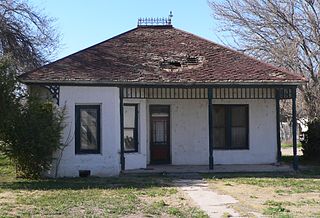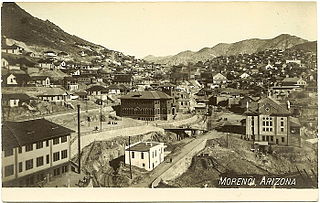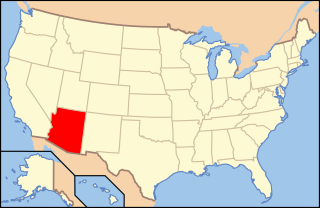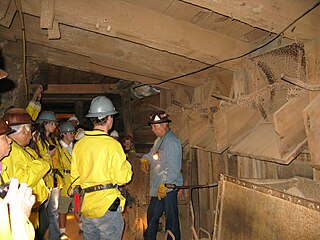
Greenlee County is a county in the southeastern part of the U.S. state of Arizona. As of the 2020 census, the population was 9,563, making it Arizona's least populous county. The county seat is Clifton.

Morenci is a census-designated place (CDP) and company town in Greenlee County, Arizona, United States, and was founded by the Detroit Copper Mining Company of Arizona. The population was 2,000 at the 2000 census and 1,489 at the 2010 census. The biggest employer in Morenci and the owner of the town is Freeport-McMoRan, the owner of the Morenci Mine, the largest copper mining operation in North America, and one of the largest copper mines in the world. The town was a site of the Arizona Copper Mine Strike of 1983. The large open-pit mine is north of the town.

Phelps Dodge Corporation was an American mining company founded in 1834 as an import-export firm by Anson Greene Phelps and his two sons-in-law William Earle Dodge, Sr. and Daniel James. The latter two ran Phelps, James & Co., the part of the organization based in Liverpool, England. The import-export firm at first exported United States cotton from the Deep South to England and imported various metals to the US needed for industrialization. With the expansion of the Western frontier in North America, the corporation acquired mines and mining companies, including the Copper Queen Mine in Cochise County, Arizona and the Dawson, New Mexico coal mines. It operated its own mines and acquired railroads to carry its products. By the late 19th century, it was known as a mining company.
Freeport-McMoRan Inc., often called Freeport, is an American mining company based in the Freeport-McMoRan Center, in Phoenix, Arizona. The company is the world's largest producer of molybdenum, a major copper producer and operates the world's largest gold mine, the Grasberg mine in Papua, Indonesia.

The Arizona Eastern Railway is a Class III railroad that operates 206 miles (332 km) of railroad between Clifton, Arizona, and Miami, Arizona, in the United States. This includes trackage rights over the Union Pacific Railroad between Lordsburg, New Mexico, and Bowie, Arizona. The railroad serves the copper mining region of southeastern Arizona, and the agricultural Gila River Valley. The railroad offers a transload location for lumber, building materials and other consumer commodities at Globe, Arizona, and can handle railcars weighing up to 286,000lbs. As of 2023, AZER has one interchange, with Union Pacific in Lordsburg, New Mexico.

James Walter Douglas was a British North America born mining engineer and businessman who introduced a number of metallurgical innovations in copper mining and amassed a fortune through the copper mining industry of Bisbee, Arizona Territory and Sonora before and after the turn of the 20th century.
The 1983 Arizona copper mine strike began as a labour dispute between the Phelps Dodge Corporation and a group of union copper miners and mill workers, led by the United Steelworkers. The subsequent strike lasted nearly three years and resulted in the replacement of most of the striking workers and decertification of the unions. It is regarded as an important event in the history of the United States labor movement.
Louis S. Cates was an American mining engineer and businessman. He was president of Phelps Dodge from 1930 to 1947.

Louis Davidson Ricketts was an American economic geologist, metallurgist, mining engineer and banker who pioneered development of copper mines in the U.S. state of Arizona and the Mexican state of Sonora.

Daniel Willis James was the son of an American merchant who with his cousin, William Earl Dodge Jr., transformed Phelps, Dodge & Co. from a predominantly mercantile business into one of the largest copper producers in the world.

In Arizona, copper mining has been a major industry since the 19th century. In 2007, Arizona was the leading copper-producing state in the country, producing 750 thousand metric tons of copper, valued at $5.54 billion. Arizona's copper production was 60% of the total for the United States. Copper mining also produces gold and silver as byproducts. Byproduct molybdenum from copper mining makes Arizona the nation's second-largest producer of that metal. Although copper mineralization was found by the earliest Spanish explorers of Arizona, the territory was remote, and copper could seldom be profitably mined and shipped. Early Spanish, Mexican, and American prospectors searched for gold and silver, and ignored copper. It was not until the completion of the Southern Pacific Railroad in 1876 that copper became broadly economic to mine and ship to market.

The Copper Queen Mine was a copper mine in Cochise County, Arizona, United States. Its development led to the growth of the surrounding town of Bisbee in the 1880s. Its orebody ran 23% copper, an extraordinarily high grade. It was acquired by Phelps Dodge in 1885.
The El Paso and Southwestern Railroad began in 1888 as the Arizona and South Eastern Railroad, a short line serving copper mines in southern Arizona. Over the next few decades, it grew into a 1200-mile system that stretched from Tucumcari, New Mexico, southward to El Paso, Texas, and westward to Tucson, Arizona, with several branch lines, including one to Nacozari, Mexico. The railroad was bought by the Southern Pacific Railroad in 1924 and fully merged into its parent company in 1955. The EP&SW was a major link in the transcontinental route of the Golden State Limited.
The Detroit Copper Mining Company was an American copper mining and smelting operation based in Morenci, Arizona. Incorporated in July 1872, it existed as an independent company until 1897, when a controlling interest in the company was purchased by the predecessor of the Phelps Dodge Corporation. It continued to exist as a subsidiary of Phelps Dodge & Co until 1917, when all Phelps Dodge operations in the area were consolidated into the new Phelps Dodge Corporation, Morenci Branch.

Helvetia is a ghost town in Pima County, Arizona, United States that was settled in 1891 and abandoned in the early 1920s. Helvetia is an ancient name for Switzerland. Today, only the Ray Mine and cemetery are visitable, as the rest of the town has been fenced off due to active mining operations.
Cedar was a gold, silver and copper mining town in Mohave County, Arizona, United States. It was founded circa 1875 on the eastern slope of the Hualapai Mountains, sixty miles southeast of Kingman. A post office was established on September 24, 1895, and closed on July 31, 1911. In addition to the post office there were two saloons, and a general store with several homes. In 1907 the Cedar Valley Gold & Silver Company along with the Yucca Cyanide Mining & Milling Company reported that approximately 200 people lived in the town, within a decade later the site was abandoned. A half mile area inside Cedar Valley is littered with stone ruins and foundations of the mining buildings.

The Morenci Mine is a large copper mine located near Morenci, Arizona, United States. Morenci represents one of the largest copper reserves in the United States and in the world, having estimated reserves of 3.2 billion tonnes (3.5×109 short tons) of ore grading 0.16% copper. It is located in Greenlee County, just outside the company town of Morenci and the town of Clifton. Freeport-McMoRan is the principal owner and, since 2016, Sumitomo Group has owned a 13% interest in the mine.
Charles E. Mills was an American businessman and banker. Born in Illinois and raised in Iowa, Mills went to the Arizona Territory and applied his engineering education in the mining industry. Except for a return east for two years while studying at Harvard University, and time in the military during the Spanish–American War and World War I, he remained in Arizona where he managed several mining operations. He also entered the banking industry in the territory, and ended his career as president of two prominent Arizona corporations, the Apache Powder Company and the Valley Bank of Arizona.













